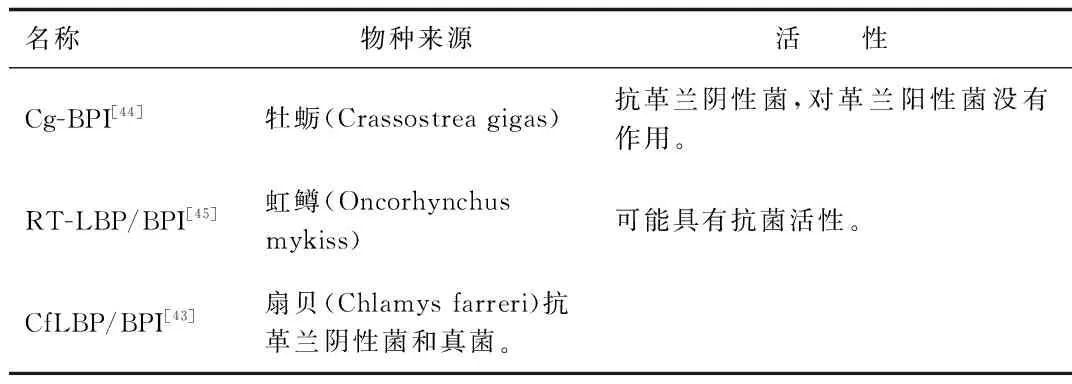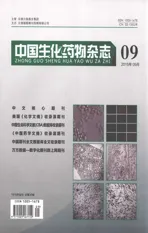海洋来源抗菌活性蛋白研究进展
2015-07-07周永红柳国艳周茂林张慧张黎明
周永红,柳国艳,周茂林,张慧,张黎明Δ
(1.第二军医大学 海洋生物医药研究中心,上海 200433;2.第二军医大学 海军医学系 海洋生物技术教研室,上海 200433;3.宁乡县疾病预防控制中心,湖南 长沙 410600)
海洋来源抗菌活性蛋白研究进展
周永红1,2,柳国艳1,2,周茂林3,张慧1,2,张黎明1,2Δ
(1.第二军医大学 海洋生物医药研究中心,上海 200433;2.第二军医大学 海军医学系 海洋生物技术教研室,上海 200433;3.宁乡县疾病预防控制中心,湖南 长沙 410600)
海洋生物的生存环境和代谢产物与陆地生物不同,产生并积累了大量具有特殊化学结构和生理活性的物质,是开发新型海洋药物的重要资源。目前已发现的海洋抗菌活性物质主要来源于海洋无脊椎动物、鱼类和海洋微生物。本文主要就海洋来源的抗菌肽和抗菌蛋白研究现状与发展趋势作一简要概述。
海洋来源活性物质;抗菌肽;抗菌活性蛋白
随着海洋渔业和滨海旅游业的迅速发展,海洋微生物感染的伤情越来越多见。《2010年首次海洋生物普查计划》报告显示,约90%的海洋生物为微生物,共计10亿余种[1]。其中不仅有陆地常见的病原微生物,也有海水中特有的致病微生物,如各种弧菌。皮肤和软组织创面长时间接触海水极易引起感染,并可在短时间内造成严重损伤,甚至危及生命[2]。常用抗生素对海水浸泡后的海洋微生物感染疗效欠佳,亟需寻找新型抗海洋致病菌的活性物质[3]。
海洋生物生存于海洋环境,经过长期适应可能代谢生成针对海洋致病菌的系列活性物质,因而从海洋生物资源获取抗菌活性物质成为研究热点之一。已发现的海洋抗菌活性物质包括抗菌肽、溶菌酶、凝集素以及多种小分子化合物,他们主要来源于海洋无脊椎动物、鱼类和海洋微生物。本文主要就海洋来源的抗菌肽和抗菌蛋白的研究现状与发展趋势作一简要概述。
1 海洋来源的抗菌肽
1.1 海洋无脊椎动物抗菌肽 海洋无脊椎动物缺乏后天免疫系统多样化的抗体,仅依靠先天免疫系统抵抗入侵细菌或病原体,在漫长的自然选择压力和复杂的海洋环境作用下,海洋无脊椎动物的先天免疫系统进化、发育得非常有效且功能强大,能够代谢产生或分泌一系列抗菌活性物质来进行自我保护。因此,海洋无脊椎动物成为筛选新型抗感染药物的重要资源库。
海洋无脊椎动物来源抗菌肽的分子量大多小于10 kDa,含有α-螺旋,具有亲脂性和亲水性(双亲性),其中大部分具有独特的序列和结构特征,和其他已知抗菌肽的同源性较低。这类抗菌肽主要来源于海洋刺胞动物(例如水母、水螅)、环节动物(例如沙蚕)、节肢动物(例如对虾、蟹、鲎)、棘皮动物(例如海参、海胆)、原索动物(例如海鞘、文昌鱼)和软体动物(例如贻贝)。
刺胞动物大部分属于无脊椎海洋浮游生物,种类繁多,分布广泛。由于刺胞动物的体腔开放浸泡于海水之中,与海水接触面积大,体表及体腔接触各种微生物,因而其机体组织抗菌肽的表达量较高。已分离到的抗菌肽有水母素[4]和Pd-AMP1[5]等。这类抗菌肽分子量小,均与已知的抗菌肽无同源性,具有广谱抗菌活性,对人红细胞没有或仅有较低的溶血活性。
海洋环节动物主要为多毛纲,是两侧对称、分节的裂生体腔动物,是海洋无脊椎动物中较大的类群之一。由于其特殊的生态环境,在沙蚕和水蛭等中发现了大量抗菌肽,如perinerin[6]和水蛭素[7]。这类抗菌肽具有螺旋-转角-螺旋的结构,表现出明显的双亲性或是含有特殊的二硫键结构,大部分对革兰阳性菌、革兰阴性菌和真菌都具有明显的抗菌活性。
海洋节肢动物是种类最多的海洋无脊椎动物类群,由于它们的壳在生长过程中会定期脱换,为适应复杂的海洋生态系统,防止微生物感染,其体内产生了大量抗菌活性物质。已提取到的抗菌肽主要来源于鲎、蟹和虾等,如鲎素[8]、arasin1[9]和PJD[10]等。这类抗菌肽通常含有2个以上的二硫键结构,能抑制革兰阴性菌和革兰阳性菌的生长,少数也具有抗真菌和抗病毒活性。
海洋棘皮动物大部分营底栖生活,外观差别大,从浅海到数千米的深海都有广泛分布。棘皮动物移动缓慢,但先天免疫系统功能强大,已分离到的抗菌肽有来自海胆的strongylocins[11]等。这类抗菌肽大部分属于阳离子多肽,富含半胱氨酸,具有抗革兰阴性菌和革兰阳性菌作用。
海洋原索动物抗菌肽大部分来源于海鞘。海鞘外形类似于椭圆形的囊袋,身体有孔道以过滤浮游生物和有机物颗粒为生,其体内抗菌肽的含量亦较高。已得到的海鞘抗菌肽种类丰富,如clavanins[12]和styelins[13]等。这类抗菌肽大多富含组氨酸,具有Α-螺旋和双亲性,对革兰阳性菌和革兰阴性菌具有强力杀菌作用,尤其是海洋来源的细菌;部分还具有抗真菌活性。
软体动物种类丰富,包括各种贝类、螺类等。已从软体动物中发现了许多具有抗病毒及抗菌作用的活性物质。在海洋软体动物中,对贻贝来源的抗菌肽研究最多,研究结果也比较系统。根据贻贝抗菌肽的一级结构和二硫键的构成方式,这类抗菌肽可分为4类,见表1。

表1 海洋贻贝来源的抗菌肽Tab.1 Antimicrobial peptides derived from marine mussels
1.2 海洋鱼类抗菌肽 鱼类是最古老的脊椎动物,分布十分广泛,从赤道到两极、从海水表面到万米左右的深海都有不同种类的鱼群。由于特殊的生活环境,促成了海洋鱼类的生理结构及其代谢产物的多样性和独特性。大部分从海洋鱼类发现的抗菌活性物质来自鱼类的表皮黏液。
从海洋鱼类提取到的抗菌肽,按照结构特征大致可以分为以下几类:具有双亲性和Α -螺旋结构的线性抗菌肽,如piscidins[18]和SHβAP[19]等,这类抗菌肽具有广谱抗菌活性,无溶血活性;富含半胱氨酸的小分子肽,如Hepcidin[20]和EC-hepcidins[21]等,这类抗菌肽抗菌谱较窄,能抑制部分革兰阳性菌或革兰阴性菌,如创伤弧菌和金黄色葡萄球菌;属于组蛋白H2A的一类,如parasin 1[22]和OncomyncinⅡ[23]等,其具有广谱抗菌活性,主要通过破坏细菌细胞膜的稳定起到杀菌作用;四是其他类,如cathelicidins[24]和codCath[25]等,这类抗菌肽结构各具特色,均具有广谱抗菌活性,部分还具有抗寄生虫活性。
2 海洋来源的外源性凝集素
凝集素作为一种非特异性识别因子,能识别自身和异己成分,包括外来入侵的病原菌,并可通过凝集、包围、调理、促进吞噬等方式将其排出体外;另外,凝集素还参与止血、凝固、物质运输及创伤修复等一系列作用,是先天免疫系统的重要组成部分。
海洋来源的凝集素主要来自海洋无脊椎动物,已从其中分离到大量凝集素,如鲎血细胞中发现的Tachylectin类凝集素,分子量14 kDa到40 kDa不等,均能抑制革兰阴性菌、阳性菌和真菌的生长,其中Tachylectin-5的抗菌活性最强[26];Hatakeyama T等[27]发现的CEL类凝集素仅对革兰阳性菌有较强的抗菌活性,对革兰阴性菌无作用;Takahashi KG等从蛤仔中分离到的14 kDa的MCL-4能特异性针对海洋致病性弧菌[28];Luo T等[29]发现的PmLec具有调理素作用,可增强血细胞的吞噬能力。
3 溶菌酶
溶菌酶在自然界分布十分广泛,具有广谱抗菌活性,是生物体重要的非特异性免疫因子之一。溶菌酶是一种能水解细菌细胞壁粘多糖的碱性酶,它能破坏细菌细胞壁中粘多糖N-乙酰胞壁酸和N-乙酰葡萄糖胺之间的β-1, 4糖苷键,导致细菌细胞壁裂解,从而使细菌死亡[30]。由于无脊椎动物缺乏后天性免疫系统,溶菌酶是其先天免疫系统的重要组成部分。目前提取到的溶菌酶主要来源于贝类,如紫贻贝和扇贝等。这类溶菌酶大多属于Ⅰ型(例如bm-lysozyme、sB-lysozyme、sC-lysozyme、sA-lysozyme等[31])、G型(例如CFLysG[32]和 MGgLYZ[33]等)和C型(AmphiLysC[34]),分子量10kDa到30kDa不等,大部分具有广谱抗菌活性,参与机体的免疫反应,部分还具有消化酶功能。
4 海洋来源的蛋白酶抑制剂
蛋白酶抑制剂主要分为2类:丝氨酸蛋白酶抑制剂(serine protease inhibitors, SPI)和半胱氨酸蛋白酶抑制剂(cystatin)。SPI广泛存在于动植物和微生物中,在免疫调节与防御中发挥着重要作用,例如对病原的选择消化,抑制真菌和细菌蛋白酶的活性等,从而保护机体免受病原微生物侵害。SPI主要包括:α-巨球蛋白、serpin、Kunitz和Kazal等种类[35]。cystatin除了具有独特的抑制半胱氨酸蛋白酶(如组织蛋白酶cathepsin B、L、S和天冬酰胺内肽酶AEP)活性外,还具有免疫调节活性,如Cystatin在炎症反应和微生物防御过程中起到重要作用,可协助机体杀死致病菌[36]。海洋来源的具有抗菌活性的蛋白酶抑制剂主要是SPI,如SPIPm2[37]和rPtSerpin等[38],这类抗菌蛋白分子量差异大,10 kDa到100 kDa不等,大部分能抑制革兰阴性菌生长,如溶藻弧菌,但不具有抗革兰阳性菌和真菌的作用。RbCyt B[39]和RpCyt B[40]分别发现于石鲷鱼和蛤仔,分子量均为11 kDa,具有抗革兰阴性菌作用,属cystatin类。
5 海洋来源的杀菌/通透性增加蛋白
杀菌/通透性增加蛋白(batericidal permeability increasing protein,BPI)是主要存在于人、兔、牛、猪等多种哺乳动物嗜中性粒细胞中的一种阳离子抗菌蛋白,具有中和内毒素和杀伤革兰阴性菌的作用[41]。BPI能与革兰阴性菌脂多糖(lipopolysaccharides,LPS)结合,除了中和内毒素和杀灭细菌的作用外,近年来BPI的一些新功能也陆续被发现,包括促进补体活化,增强调理功能[42]、抗真菌作用[43]和抗原虫作用。BPI蛋白是目前发现的唯一既能非特异性杀伤革兰阴性菌,又能中和内毒素,同时具有免疫调理等作用的抗菌物质,大量实验和临床应用显示了其在治疗革兰阴性杆菌感染及其内毒素引起的疾病中的保护作用。对BPI的深入研究,将为许多疾病的治疗带来新的希望。见表2。

表2 海洋来源的BPITab.2 BPI derived from marine
6 结语与展望
近年来,由于抗生素的长期使用和滥用导致耐药性菌株越来越多,人类亟需寻找新型的抗菌药物。2010年第一份国际海洋生物普查计划报告的出炉,加深了人类对海洋生物的认识。得益于海洋特殊生态环境,海洋生物的生理结构和代谢产物与陆地生物不同,一些海洋生物产生并积累了大量具有特殊化学结构、特异抗菌活性的抗菌肽和抗菌蛋白,是开发新型海洋抗菌药物的重要资源。尽管在海洋生物活性物质的研究热潮中发现的海洋抗菌蛋白越来越多,但相对于种类繁多、数量巨大的海洋生物资源而言,海洋抗菌肽和抗菌蛋白的发掘才刚刚起步。我国是海洋大国,开发和利用海洋抗菌肽和抗菌蛋白资源,将为研制肽类新药提供理想分子的设计骨架和模板,为发展新型抗感染药物奠定重要基础。
抗菌肽和抗菌蛋白在医药研发、食品保存、农业抗病虫害、水产养殖等方面有很高的关注度,得到全世界科研人员的普遍关注和青睐。在医药研发方面,由于抗菌肽具有广谱抗细菌、真菌、病毒、寄生虫和抗肿瘤功能及独特的作用机理[46],且具有高效性和安全性,其对常见病原微生物半致死剂量平均在几十微摩尔浓度以内,而对正常真核细胞几乎没有损害[47],因此其极有可能成为抗菌、抗病毒以及抗肿瘤药物的新来源。在食品药品方面,可作为新型食品防腐剂;可添加到食品中,制作各种功能食品,且仍能保持原有的生理活性不变;可直接制作口服剂型药品、保健品、营养品等。在农业抗病虫害和水产养殖方面,抗菌肽一方面可以作为农药添加剂,大大减少农药用量,降低环境污染指数,生产出绿色农产品;另一方面作为抗生素的替代品,用作饲料添加剂,减少动物喂养过程中对抗生素的依赖,从而减少人类通过食品链摄取抗生素的量。此外,还可以借助基因工程技术将广谱抗菌肽基因导入动植物体内,提高动植物对各种致病菌的抵抗能力。
[1] Jesse H. Ausubel. First census of marine life 2010: Highlights of a decade of discovery[M]. Census of Marine Life, 2010.
[2] Melchers, RE. Modelling of marine immersion corrosion for copper-bearing steels[J].Corrosion Science, 2003, 45(10), 2307-2323.
[3] Zheng L,Bae YM,Jung KS,et al. Antimicrobial activity of natural antimicrobial substances against spoilage bacteria isolated from fresh produce[J].Food Control, 2013, 32(2):665-672.
[4] Ovchinnikova TV, Balandin SV, Aleshina GM, et al. Aurelin, a novel antimicrobial peptide from jellyfishAureliaauritawith structural features of defensins and channel-blocking toxins[J]. Biochem Biophys Res Commun, 2006, 348(2): 514-523.
[5] de Lima LA,Migliolo L,Barreiro e Castro C,et al. Identification of a novel antimicrobial peptide from Brazilian coast coral Phyllogorgia dilatata[J].Protein Pept Lett,2013, 20(10):1153-1158.
[6] Pan W, Liu X, Ge F, et al. Perinerin, a novel antimicrobial peptide purified from the clamworm Perinereisaibuhitensisgrube and its partial characterization[J]. J Biochem, 2004, 135(3):297-304.
[7] Tasiemski A,Vandenbulcke F, Mitta G, et al. Molecular characterization of two novel antibacterial peptides inducible upon bacterial challenge in an annelid, the leech Theromyzontessulatum[J]. J Biol Chem, 2004, 279(30):30973-30982.
[8] Nakamura T, Furunaka H,Miyata T,et al. Tachyplesin, a class of antimicrobial peptide from the hemocytes of the horse shoe crab (Tachypleustridentatus), isolation and chemical structure[J].J Biol Chem,1988, 263(32):16709-16713.
[9] Stensvag K, Haug T, Sperstad SV, et al. Arasin 1, a proline-arginine-rich antimicrobial peptide isolated from the spider crab, Hyasaraneus[J]. Dev Comp Immunol,2008, 32(3):275-285.
[10] Pisuttharachai D, Yasuike M, Aono H, et al. Expressed sequence tag analysis of phyllosomas and hemocytes of Japanese spiny lobster Panulirusjaponicus[J].Fisheries Sci,2009, 75(1):195-206.
[11] Li C, Haug T, Styrvold OB, et al. Strongylocins, novel antimicrobial peptides from the green sea urchin, Strongylocentrotus droebachiensis[J]. Dev Comp Immunol, 2008, 32(1):1430-1440.
[12] Lee IH, Zhao C, Cho Y, et al. Clavanins, alpha-helical antimicrobial peptides from tunicate hemocytes[J]. Febs Letters, 1997, 400(2):158-162.
[13] Lee,IH Cho Y,Lehrer RI. Styelins, Broad-Spectrum Antimicrobial Peptides from the Solitary Tunicate, Styelaclava[J]. Comp Biochem Physiol B Biochem Mol Biol, 1997, 118(3):515-521.
[14] Charlet M,Chernysh S,Philippe H,et al. Innate immunity. Isolation of several cysteine-rich antimicrobial peptides from the blood of a mollusc, Mytilusedulis[J].J Biol Chem,1996, 271(36):21808-21813.
[15] Gonzalez M, Gueguen Y, Desserre G, et al. Molecular characterization of two isoforms of defensin from hemocytes of the oyster Crassostrea gigas[J]. Dev Comp Immunol, 2007, 31(4):332-339.
[16] Mitta G, Vandenbulcke F, Roch P. Original involvement of antimicrobial peptides in mussel innate immunity[J]. FEBS Lett, 2000, 486(3):185-190.
[17] Padhi A, Verghese B. Molecular diversity and evolution of myticin-C antimicrobial peptide variants in the Mediterranean mussel, Mytilusgalloprovincialis[J]. Peptides, 2008, 29(7):1094-1101.
[18] Silphaduang U, Noga EJ. Peptide antibiotics in mast cells of fish[J]. Nature, 2001, 414(5):268-269.
[19] Seo JK, Lee MJ, Jung HG, et al. Antimicrobial function of SHβAP, a novel hemoglobin β chain-related antimicrobial peptide, isolated from the liver of skipjack tuna,Katsuwonus pelamis[J]. Fish Shellfish Immunol,2014, 37(1):173-183.
[20] Lauth X, Babon JJ, Stannard JA, et al. Bass hepcidin synthesis, solution structure, antimicrobial activities and synergism, and in vivo hepatic response to bacterial infections[J]. J Biol Chem, 2005, 280(10):9272-9282.
[21] Zhou JG, Wei JG, Xu D, et al. Molecular cloning and characterization of two novel hepcidins from orange-spotted grouper,Epinepheluscoioides[J].Fish Shellfish Immunol,2011, 30(2):559-568.
[22] Cho JH,Park IY,Kim MS, et al. Matrix metalloproteinase 2 is involved in the regulation of the antimicrobial peptide parasin I production in catfish skin mucosa[J].FEBS Lett,2002, 531(3):459-463.
[23] Fernandes JM, Kemp GD, Molle MG, et al. Anti-microbial properties of histone H2A from skin secretions of rainbow trout, Oncorhynchusmykiss[J].Bioche J, 2002, 368(Pt 2):611-620.
[24] Chang CI,Zhang YA,Zou J,et al.Two cathelicidin genes are present in both rainbow trout (Oncorhynchusmykiss) and atlantic salmon (Salmosalar)[J].Antimicrob Agents Chemother, 2006, 50(1):185-195.
[25] Broekman DC, Zenz A, Gudmundsdottir BK, et al. Functional characterization of codCath, the mature cathelicidin antimicrobial peptide from Atlantic cod (Gadusmorhua)[J].Peptides,2011, 32(10):2044-2051.
[26] Kawabata S, Iwanaga S.Role of lectins in the innate immunity of horseshoe crab[J]. Dev Comp Immunol, 1999, 23(4-5):391-400.
[27] Hatakeyama T, Kohzaki H, Nagatomo H, et al. Purification and characterization of four Ca(2+)-dependent lectins from the marine invertebrate, Cucumaria echinata[J]. J Biochem, 1994, 116(1):209-214.
[28] Takahashi KG, Kuroda T, Muroga K. Purification and antibacterial characterization of a novel isoform of the Manila clam lectin (MCL-4) from the plasma of the Manila clam, Ruditapes philippinarum[J]. Comp Biochem Phys Part B Bioche Mol Biol, 2008, 150(1):45-52.
[29] Luo T, Yang H, Li F, et al. Purification, characterization and cDNA cloning of a novel lipopolysaccharide-binding lectin from the shrimp Penaeus monodon[J]. Dev Comp Immunol, 2006, 30(7):607-617.
[30] Nilsen IW, Overbo K, Sandsdalen E, et al. Protein purification and gene isolation of chlamysin, a cold-active lysozyme-like enzyme with antibacterial activity[J]. FEBS Lett, 1999, 464(3):153-158.
[31] Olsen Ø M, Nilsen IW, Sletten K, et al. Multiple invertebrate lysozymes in blue mussel (Mytilus edulis)[J]. Comp Biochem Physiol B Biochem Mol Biol, 2003, 136(1):107-115.
[32] Zhao J, Song L, Li C, et al. Molecular cloning of an invertebrate goose-type lysozyme gene from Chlamys farreri, and lytic activity of the recombinant protein[J]. MolImmunol, 2007, 44(6):1198-1208.
[33] Wang Q, Zhang L, Zhao J, et al. Two Goose-Type Lysozymes in Mytilusgalloprovincialis: Possible Function Diversification and Adaptive Evolution[J]. Plos One, 2012, 7(9):1472-1472.
[34] Liu M, Zhang S, Liu Z, et al. Characterization, organization and expression of AmphiLysC , an acidic c-type lysozyme gene in amphioxus Branchiostoma belcheri tsingtauense[J]. Gene, 2006, 367(1):110-117.
[35] Jr LM, Kato I. Protein inhibitors of proteinases[J]. Annu Rev Biochem,1980, 49:593-626.
[36] Kopitar-Jerala N. The role of cystatins in cells of the immune system[J]. FEBS Lett, 2006, 580(27):6295-6301.
[37] Donpudsa S, Tassanakajon A, Rimphanitchayakit V. Domain inhibitory and bacteriostatic activities of the five-domain Kazal-type serine proteinase inhibitor from black tiger shrimp Penaeus monodon[J]. Dev Comp Immunol, 2009, 33(4):481-488.
[38] Liu Y, Shi G, Cui Z, et al. PtSerpin from the swimming crab Portunustrituberculatus, a putative regulator of prophenoloxidase activation with antibacterial activity[J]. Fish Shellfish Immunol, 2014, 39(2):365-371.
[39] Premachandra HK, Whang I, Lee YD, et al.Cystatin B homolog from rock bream Oplegnathusfasciatus: genomic characterization, transcriptional profiling and protease-inhibitory activity of recombinant protein[J].Comp Biochem Physiol B Biochem Mol Biol,2012, 163(1):138-146.
[40] Premachandra HK, Elvitigala DA, Whang I, et al. Expression profile of cystatin B ortholog from Manila clam (Ruditapes philippinarum) in host pathology with respect to its structural and functional properties[J]. Fish Shellfish Immunol, 2013, 34(6):1505-1513.
[41] Weiss J, Victor M, Elsbach P. Role of charge and hydrphobic interactions in the action of the bactericidal/permeability-increasing protein of neutrophils on gram-negative bacteria[J].Clin Invest,1983,71(3):540-549.
[42] Canny G, Cario E, Lennartsson A, et al. Functional and biochemical characterization of epithelial bactericidal/permeability-increasing protein[J].Am J Physiol Gastrointest Liver Physiol,2006,290(3):557-567.
[43] Feng Y, Zhi Z, Wang L, et al. Maternal transfer of immunity in scallop Chlamysfarreri and its trans-generational immune protection to offspring against bacterial challenge[J]. Dev Comp Immunol, 2013, 41(4):569-577.
[44] Gonzalez M,Gueguen Y,Destoumieux-Garzón D,et al. Evidence of a bactericidal permeability increasing protein in an invertebrate, the Crassostrea gigas Cg-BPI[J]. Pro Nati Acad Sci, 2007, 104(45):17759-17764.
[45] Inagawa H,Honda T,Kohchi C,et al. Cloning and characterization of the homolog of mammalian lipopolysaccharide-binding protein and bactericidal permeability-increasing protein in rainbow trout Oncorhynchusmykiss[J]. J Immunol, 2002, 168(11):5638-5644.
[46] Boulanger N, Ehret-Sabatier L, Brun R, et al. Immune response of Drosphila melanogaster to infection with the flagellate parasite Crithidia spp[J].Insect Biotechem Mol Biol,2001,31(2):129-137.
[47] Jaynes JM, Burton CA, Barr SB, et al. In vitro cytocidal effect of novel lyric peptides on Plasmodium falciparum and Trypanosoma cruzi[J]. FASEB J,1988,2(13):2878-2883.
(编校:王冬梅)
Progresses on marine antimicrobial activity proteins
ZHOU Yong-hong1,2, LIU Guo-yan1,2, ZHOU Mao-lin3, ZHANG Hui1,2, ZHANG Li-ming1,2Δ
(1.Marine biomedical research center, The Second Military Medical University, Shanghai 200433, China; 2.Teaching and Research Section of Marine Biotechnology, Department of Naval Medicine, The Second Military Medical University, Shanghai 200433, China; 3.Ningxiang County Center for Disease Control and Prevention, Changsha 410600, China)
Due to the particularity of marine ecological environment, many marine lives have developed and accumulated a large amount of biological molecules with special chemical structures and physiological activities, representing an important resource for the development of marine drugs. Generally, the marine antibacterial proteins are mainly identified from the marine microorganisms, invertebrates and fish. In this review, the progresses on marine antibacterial peptides and antimicrobial activity proteins are briefly summarized.
marine bioactive substances; antibacterial peptides; antimicrobial activity proteins
国家自然科学基金(41306136;81370833)
周永红,女,硕士在读,研究方向:海洋生物活性物质研究,E-mail: 171006165@qq.com;张黎明,通讯作者,男,教授,博士生导师,研究方向:海洋生物活性物质以及海洋生物伤治防治研究,E-mail:lmzhang@smmu.edu.cn。
R282.77,Q51
A
1005-1678(2015)09-0170-04
